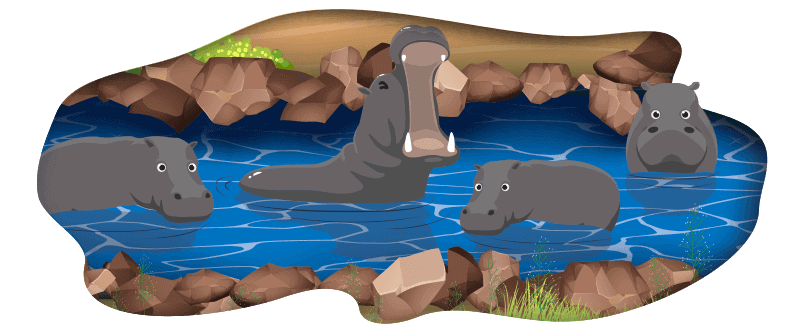Winning Now:


R487,778.38
Johanna C V. on Rudolphs Revenge

R200,000.00
Anthony F. on Fjord's Fortune

R45,220.00
Monique V. on The Cash is Right

R42,000.00
Tania R. on Fire Dragon

R41,400.00
Jonathan H. on Sweet 16

R37,500.00
Roelien R. on Sweet 16

R31,250.00
Same S. on Sweet 16

R27,570.00
Steph Z. on Super 6

R25,596.00
Tanika K. on Panda's Gold

R25,200.00
Marlene K. on RTG777


International Hippo Day 15 February 2021
This month we’re celebrating an iconic African animal: the hefty hippopotamus.
Via Latin from ancient Greek, the name ‘hippopotamus’ means ‘horse of the river’ ¬or ‘river horse’ (hippos – horse, potamos – river). Hippos may resemble pigs, but their closest living relatives are actually cetaceans – whales, dolphins and porpoises, from whom they began to diverge from about 55 million years ago. Read on for some more interesting facts about this heavyweight member of Africa’s megafauna.
Where do hippos live?
Nowadays, hippos are found in rivers and lakes throughout many sub-Saharan countries. However, in ancient times they were also common in the Nile River in Egypt. They were both feared and revered, with quite a few gods depicted in their form. Unfortunately, because of attacking people and destroying crops, as well as for their meat and ivory teeth, they were hunted to extinction
In South Africa, the largest number of hippos can be found in the Lake St Lucia area, numbering about 800. Every now and then a few hippos can sometimes be seen in the streets of the nearby town at night on their way to graze. They are also located in the Kruger National Park and other nature reserves wherever there are lakes, vleis or rivers.
Hippos are not as fat as they seem
Compared to the blue whale (the world’s largest animal by far), where 35% of its weight is fat, a hippo is rather a lightweight in the fat stakes. Instead, its round body is covered in a 5 cm thick layer of hairless skin, and underneath that only a moderate fat layer. Instead, their skin accounts for a whopping 18% of their body weight!
After elephants and white rhinos, hippos are the third-largest land animal. A fully-grown hippo weighs about 1,500 kg, and large males can weigh up to 2,000 kg. But don’t be fooled by their dumpy appearance and short legs – a hippo can reach speeds of up 30km per hour – faster than most humans and therefore very dangerous. In fact hippos kill more peoplae than any other animal in Africa. Did we mention that they can be very aggressive and bad-tempered?
An average day for a hippo
During the day, hippos spend up to 16 hours in water to keep cool, with just their ears, eyes and nostrils appearing above the water line. Hippos usually gather in large groups in water, probably for protection against predators like crocodiles.
At night, hippos come onto land to go foraging for food, usually various grasses and reeds. They don’t chew their food but just crop or tear up the plant material using their lips and teeth and immediately swallow it. Hippos have long digestive tracts, allowing extraction of as many nutrients as possible.
When on land, this is the time when they are most dangerous to humans, and sometimes other animals. While mainly herbivorous, hippos have been known to kill and eat animals like kudu and even buffalo! They have enormously large and sharp teeth (up to 50 cm long) and are a lot more agile than they look.
When people see hippos yawn with their mouths wide open and think of them as being calm and lazy, they couldn’t be more wrong. Rather this is a sign of aggression. Hippos are not alone in this behavior, for example baboons also ‘yawn’ as a sign of aggression, baring their teeth.
Hippo sex and procreation
Hippos are polygamous – the males mate with more than one female each season. This doesn’t happen that often ¬– only about once every two years. To find out if a female is in season, a male will sniff her urine or behind. This is a time when ferocious fights can break out among the males (with a lot of ‘yawning’ going on, showing their weapons of choice – their huge teeth).
Hippos are the only land-based animals that mate in water. The female is forcibly pushed underwater during mating and only occasionally comes up to breathe – luckily they can hold their breath for up to five minutes.
A hippo pregnancy lasts about 8 months; the mother gives birth to a calf (sometimes twins) in the water. She separates herself from the herd for about two weeks until her calf has ‘imprinted’ (recognizes her as its mother), then rejoins them.
Are hippos endangered?
Hippo numbers have drastically decreased over the years, due to habitat loss and poaching, and the species is classed as ‘vulnerable’, which is not as critical as ‘endangered’. However, it is estimated that hippos could become extinct within the next 100 years if better protection for them and their habitats is not enforced.
We love Hippos

MORE NEWS
This Easter, we are hatching something special just for you!
A Battle of Elements with Massive Jackpots!
One spin on Gemstone Keys could change everything.






